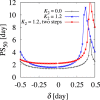Accelerating recovery from jet lag: prediction from a multi-oscillator model and its experimental confirmation in model animals
- PMID: 28443630
- PMCID: PMC5405409
- DOI: 10.1038/srep46702
Accelerating recovery from jet lag: prediction from a multi-oscillator model and its experimental confirmation in model animals
Abstract
The endogenous circadian clock drives oscillations that are completely synchronized with the environmental day-night rhythms with a period of approximately 24 hours. Temporal misalignment between one's internal circadian clock and the external solar time often occurs in shift workers and long-distance travelers; such misalignments are accompanied by sleep disturbances and gastrointestinal distress. Repeated exposure to jet lag and rotating shift work increases the risk of lifestyle-related diseases, such as cardiovascular complaints and metabolic insufficiencies. However, the mechanism behind the disruption of one's internal clock is not well understood. In this paper, we therefore present a new theoretical concept called "jet lag separatrix" to understand circadian clock disruption and slow recovery from jet lag based on the mathematical model describing the hierarchical structure of the circadian clock. To demonstrate the utility of our theoretical study, we applied it to predict that re-entrainment via a two-step jet lag in which a four-hour shift of the light-dark cycle is given in the span of two successive days requires fewer days than when given as a single eight-hour shift. We experimentally verified the feasibility of our theory in C57BL/6 strain mice, with results indicating that this pre-exposure of jet lag is indeed beneficial.
Conflict of interest statement
The authors declare no competing financial interests.
Figures


 in (b,c) after jet lag, respectively. The green curve illustrates the trajectory of ψ. Finally, we present (d) the actual time series of ψ(t) for different values of jet lag δ. The clock system re-entrains by advancing its phase for δ < δ* but by delaying it for
in (b,c) after jet lag, respectively. The green curve illustrates the trajectory of ψ. Finally, we present (d) the actual time series of ψ(t) for different values of jet lag δ. The clock system re-entrains by advancing its phase for δ < δ* but by delaying it for  , where jet lag separatrix δ* is c.a. 10.5/24.
, where jet lag separatrix δ* is c.a. 10.5/24.




Similar articles
-
From circadian clock mechanism to sleep disorders and jet lag: Insights from a computational approach.Biochem Pharmacol. 2021 Sep;191:114482. doi: 10.1016/j.bcp.2021.114482. Epub 2021 Feb 20. Biochem Pharmacol. 2021. PMID: 33617843 Review.
-
Reentrainment of the circadian pacemaker during jet lag: East-west asymmetry and the effects of north-south travel.J Theor Biol. 2018 Jan 21;437:261-285. doi: 10.1016/j.jtbi.2017.10.002. Epub 2017 Oct 4. J Theor Biol. 2018. PMID: 28987464
-
Arginine vasopressin signaling in the suprachiasmatic nucleus on the resilience of circadian clock to jet lag.Neurosci Res. 2018 Apr;129:57-61. doi: 10.1016/j.neures.2017.10.007. Epub 2017 Oct 20. Neurosci Res. 2018. PMID: 29061320
-
[Molecular and Neural Mechanisms for the Robustness of the Circadian Clock].Yakugaku Zasshi. 2015;135(11):1265-72. doi: 10.1248/yakushi.15-00206. Yakugaku Zasshi. 2015. PMID: 26521875 Review. Japanese.
-
Effects of chronic jet lag on the central and peripheral circadian clocks in CBA/N mice.Chronobiol Int. 2014 Mar;31(2):189-98. doi: 10.3109/07420528.2013.837478. Epub 2013 Oct 22. Chronobiol Int. 2014. PMID: 24147659
Cited by
-
Disturbances of Hormonal Circadian Rhythms by Light Pollution.Int J Mol Sci. 2023 Apr 14;24(8):7255. doi: 10.3390/ijms24087255. Int J Mol Sci. 2023. PMID: 37108420 Free PMC article. Review.
-
Regionality of short and long period oscillators in the suprachiasmatic nucleus and their manner of synchronization.PLoS One. 2022 Oct 18;17(10):e0276372. doi: 10.1371/journal.pone.0276372. eCollection 2022. PLoS One. 2022. PMID: 36256675 Free PMC article.
-
Conceptual Models of Entrainment, Jet Lag, and Seasonality.Front Physiol. 2020 Apr 28;11:334. doi: 10.3389/fphys.2020.00334. eCollection 2020. Front Physiol. 2020. PMID: 32411006 Free PMC article.
-
Modeling and analysis of the impacts of jet lag on circadian rhythm and its role in tumor growth.PeerJ. 2018 Jun 6;6:e4877. doi: 10.7717/peerj.4877. eCollection 2018. PeerJ. 2018. PMID: 29892500 Free PMC article.
-
Monitoring daytime differences in moderate intensity exercise capacity using treadmill test and muscle dissection.STAR Protoc. 2021 Feb 5;2(1):100331. doi: 10.1016/j.xpro.2021.100331. eCollection 2021 Mar 19. STAR Protoc. 2021. PMID: 33598660 Free PMC article.
References
-
- Comperatore C. & Krueger G. Circadian rhythm desynchronosis, jet lag, shift lag, and coping strategies. Occupational medicine (Philadelphia, Pa.) 5, 323–341 (1989). - PubMed
-
- Sack R. L. The pathophysiology of jet lag. Travel medicine and infectious disease 7, 102–110 (2009). - PubMed
-
- Kubo T. et al.. Prospective cohort study of the risk of prostate cancer among rotating-shift workers: findings from the japan collaborative cohort study. American Journal of Epidemiology 164, 549–555 (2006). - PubMed
Publication types
MeSH terms
LinkOut - more resources
Full Text Sources
Other Literature Sources

